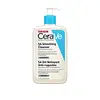What's inside
What's inside
 Key Ingredients
Key Ingredients

 Benefits
Benefits

 Concerns
Concerns

 Ingredients Side-by-side
Ingredients Side-by-side

Water
Skin ConditioningSodium Lauroyl Sarcosinate
CleansingCocamidopropyl Hydroxysultaine
CleansingGlycerin
HumectantNiacinamide
SmoothingGluconolactone
Skin ConditioningSodium Methyl Cocoyl Taurate
CleansingPEG-150 Pentaerythrityl Tetrastearate
EmulsifyingCeramide NP
Skin ConditioningCeramide AP
Skin ConditioningCeramide EOP
Skin ConditioningCarbomer
Emulsion StabilisingCalcium Gluconate
HumectantSalicylic Acid
MaskingSodium Benzoate
MaskingSodium Lauroyl Lactylate
EmulsifyingCholesterol
EmollientPhenoxyethanol
PreservativeDisodium EDTA
Tetrasodium EDTA
Hydrolyzed Hyaluronic Acid
HumectantPhytosphingosine
Skin ConditioningXanthan Gum
EmulsifyingEthylhexylglycerin
Skin ConditioningWater, Sodium Lauroyl Sarcosinate, Cocamidopropyl Hydroxysultaine, Glycerin, Niacinamide, Gluconolactone, Sodium Methyl Cocoyl Taurate, PEG-150 Pentaerythrityl Tetrastearate, Ceramide NP, Ceramide AP, Ceramide EOP, Carbomer, Calcium Gluconate, Salicylic Acid, Sodium Benzoate, Sodium Lauroyl Lactylate, Cholesterol, Phenoxyethanol, Disodium EDTA, Tetrasodium EDTA, Hydrolyzed Hyaluronic Acid, Phytosphingosine, Xanthan Gum, Ethylhexylglycerin
Water
Skin ConditioningCocamidopropyl Hydroxysultaine
CleansingStearic Acid
CleansingGlycerin
HumectantSodium Methyl Cocoyl Taurate
CleansingSodium Lauroamphoacetate
CleansingHamamelis Virginiana Water
AstringentSimmondsia Chinensis Seed Oil
EmollientCoco-Glucoside
CleansingVitis Vinifera Seed Oil
EmollientSodium Hyaluronate
HumectantOstrich Oil
Skin ConditioningChamomilla Recutita Extract
Skin ConditioningEuterpe Oleracea Fruit Extract
Avena Sativa Kernel Extract
AbrasiveCarthamus Tinctorius Seed Oil
MaskingCamellia Oleifera Leaf Extract
AstringentSodium Lauroyl Oat Amino Acids
CleansingAscorbyl Palmitate
AntioxidantTocopheryl Acetate
AntioxidantRetinyl Palmitate
Skin ConditioningPhospholipids
Skin ConditioningLaminaria Digitata Extract
Skin ProtectingChlorella Pyrenoidosa Extract
Skin ConditioningCamellia Oleifera Seed Oil
Skin ConditioningHelianthus Annuus Seed Oil
EmollientCoconut Alcohol
EmollientLauryl Glucoside
CleansingCaprylyl Glycol
EmollientCetearyl Alcohol
EmollientPolyglyceryl-2 Dipolyhydroxystearate
Skin ConditioningPolysorbate 60
EmulsifyingAcrylates/C10-30 Alkyl Acrylate Crosspolymer
Emulsion StabilisingHexylene Glycol
EmulsifyingPhenoxyethanol
PreservativePotassium Sorbate
PreservativeCI 75810
Cosmetic ColorantWater, Cocamidopropyl Hydroxysultaine, Stearic Acid, Glycerin, Sodium Methyl Cocoyl Taurate, Sodium Lauroamphoacetate, Hamamelis Virginiana Water, Simmondsia Chinensis Seed Oil, Coco-Glucoside, Vitis Vinifera Seed Oil, Sodium Hyaluronate, Ostrich Oil, Chamomilla Recutita Extract, Euterpe Oleracea Fruit Extract, Avena Sativa Kernel Extract, Carthamus Tinctorius Seed Oil, Camellia Oleifera Leaf Extract, Sodium Lauroyl Oat Amino Acids, Ascorbyl Palmitate, Tocopheryl Acetate, Retinyl Palmitate, Phospholipids, Laminaria Digitata Extract, Chlorella Pyrenoidosa Extract, Camellia Oleifera Seed Oil, Helianthus Annuus Seed Oil, Coconut Alcohol, Lauryl Glucoside, Caprylyl Glycol, Cetearyl Alcohol, Polyglyceryl-2 Dipolyhydroxystearate, Polysorbate 60, Acrylates/C10-30 Alkyl Acrylate Crosspolymer, Hexylene Glycol, Phenoxyethanol, Potassium Sorbate, CI 75810
 Reviews
Reviews

Ingredients Explained
These ingredients are found in both products.
Ingredients higher up in an ingredient list are typically present in a larger amount.
Cocamidopropyl Hydroxysultaine is a synthetic cleansing agent, though it is derived from coconut oil.
It is used to enhance the texture of products by boosting lather and thickening the texture. As a cleanser, Cocamidopropyl Hydroxysultaine is mild.
Glycerin is already naturally found in your skin. It helps moisturize and protect your skin.
A study from 2016 found glycerin to be more effective as a humectant than AHAs and hyaluronic acid.
As a humectant, it helps the skin stay hydrated by pulling moisture to your skin. The low molecular weight of glycerin allows it to pull moisture into the deeper layers of your skin.
Hydrated skin improves your skin barrier; Your skin barrier helps protect against irritants and bacteria.
Glycerin has also been found to have antimicrobial and antiviral properties. Due to these properties, glycerin is often used in wound and burn treatments.
In cosmetics, glycerin is usually derived from plants such as soybean or palm. However, it can also be sourced from animals, such as tallow or animal fat.
This ingredient is organic, colorless, odorless, and non-toxic.
Glycerin is the name for this ingredient in American English. British English uses Glycerol/Glycerine.
Learn more about GlycerinPhenoxyethanol is a preservative that has germicide, antimicrobial, and aromatic properties. Studies show that phenoxyethanol can prevent microbial growth. By itself, it has a scent that is similar to that of a rose.
It's often used in formulations along with Caprylyl Glycol to preserve the shelf life of products.
This gentle cleansing and foaming ingredient is known for leaving a smooth feeling in skin and hair. It is made using coconut oil.
According to the manufacturer, it is soluble in water and has resistance to hard water, acid, and alkali.
Due to its coconut base, it may not be Malassezia folliculitis safe.
Learn more about Sodium Methyl Cocoyl TaurateWater. It's the most common cosmetic ingredient of all. You'll usually see it at the top of ingredient lists, meaning that it makes up the largest part of the product.
So why is it so popular? Water most often acts as a solvent - this means that it helps dissolve other ingredients into the formulation.
You'll also recognize water as that liquid we all need to stay alive. If you see this, drink a glass of water. Stay hydrated!
Learn more about Water